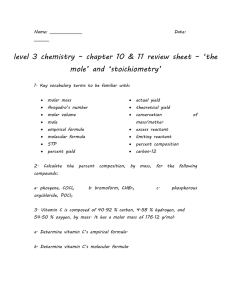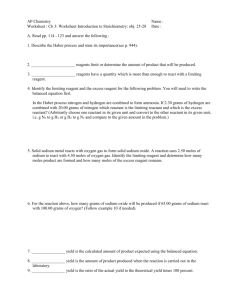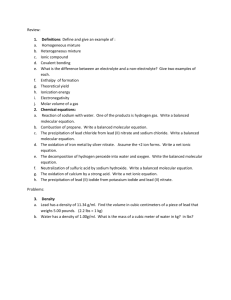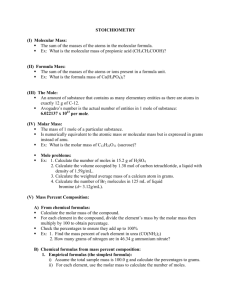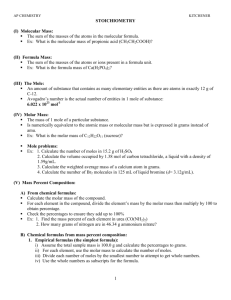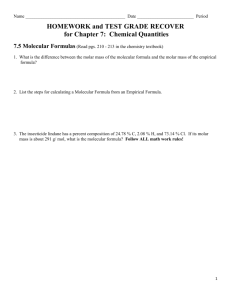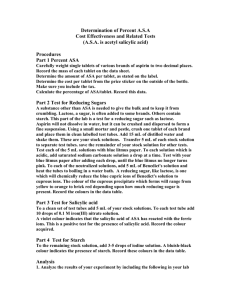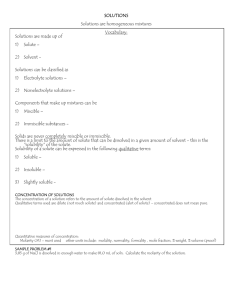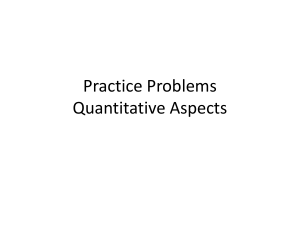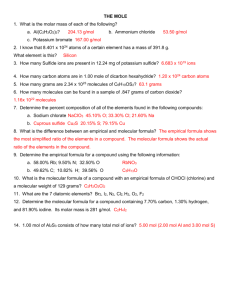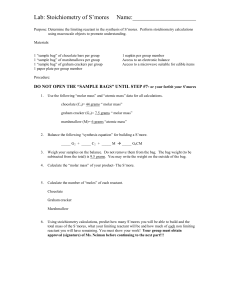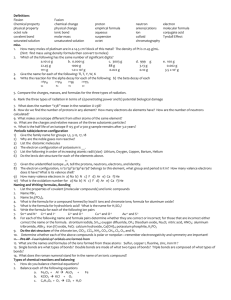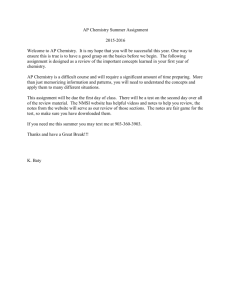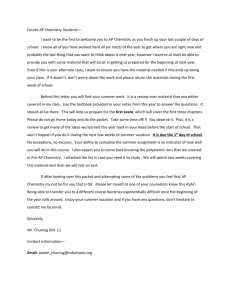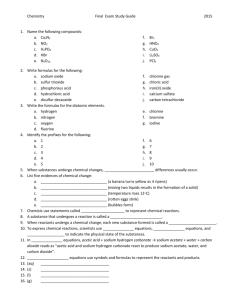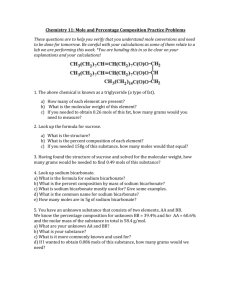Final Exam Review I. Write the formula, the name, and type of
advertisement
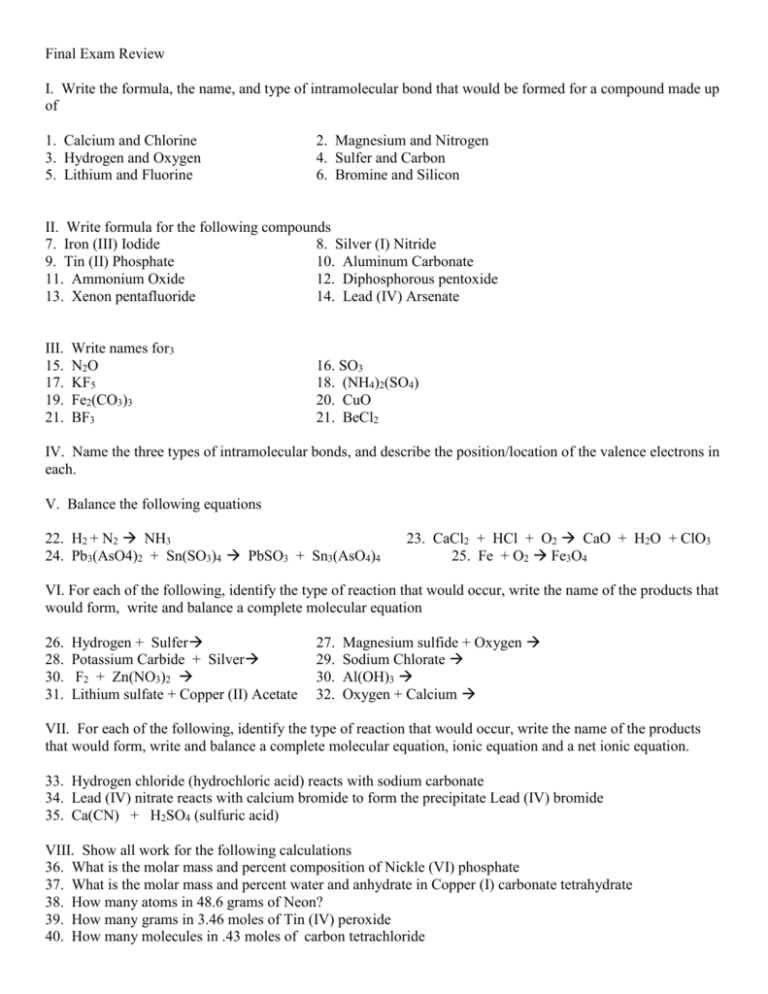
Final Exam Review I. Write the formula, the name, and type of intramolecular bond that would be formed for a compound made up of 1. Calcium and Chlorine 3. Hydrogen and Oxygen 5. Lithium and Fluorine 2. Magnesium and Nitrogen 4. Sulfer and Carbon 6. Bromine and Silicon II. Write formula for the following compounds 7. Iron (III) Iodide 8. Silver (I) Nitride 9. Tin (II) Phosphate 10. Aluminum Carbonate 11. Ammonium Oxide 12. Diphosphorous pentoxide 13. Xenon pentafluoride 14. Lead (IV) Arsenate III. 15. 17. 19. 21. Write names for3 N2O KF5 Fe2(CO3)3 BF3 16. SO3 18. (NH4)2(SO4) 20. CuO 21. BeCl2 IV. Name the three types of intramolecular bonds, and describe the position/location of the valence electrons in each. V. Balance the following equations 22. H2 + N2 NH3 24. Pb3(AsO4)2 + Sn(SO3)4 PbSO3 + Sn3(AsO4)4 23. CaCl2 + HCl + O2 CaO + H2O + ClO3 25. Fe + O2 Fe3O4 VI. For each of the following, identify the type of reaction that would occur, write the name of the products that would form, write and balance a complete molecular equation 26. 28. 30. 31. Hydrogen + Sulfer Potassium Carbide + Silver F2 + Zn(NO3)2 Lithium sulfate + Copper (II) Acetate 27. 29. 30. 32. Magnesium sulfide + Oxygen Sodium Chlorate Al(OH)3 Oxygen + Calcium VII. For each of the following, identify the type of reaction that would occur, write the name of the products that would form, write and balance a complete molecular equation, ionic equation and a net ionic equation. 33. Hydrogen chloride (hydrochloric acid) reacts with sodium carbonate 34. Lead (IV) nitrate reacts with calcium bromide to form the precipitate Lead (IV) bromide 35. Ca(CN) + H2SO4 (sulfuric acid) VIII. Show all work for the following calculations 36. What is the molar mass and percent composition of Nickle (VI) phosphate 37. What is the molar mass and percent water and anhydrate in Copper (I) carbonate tetrahydrate 38. How many atoms in 48.6 grams of Neon? 39. How many grams in 3.46 moles of Tin (IV) peroxide 40. How many molecules in .43 moles of carbon tetrachloride 41. A well-known reagent in analytical chemistry, dimethylglyoxime, has the empirical formula C2H4NO. If its molar mass is 116.1 g/mol, what is the molecular formula of the compound? 42. Nitrogen and oxygen form an extensive series of oxides with the general formula NxOy. One of them is a blue solid that comes apart, reversibly, in the gas phase. It contains 36.84% N. What is the empirical formula of this oxide? 43. An unknown compound was found to have a percent composition as follows: 47.0 % potassium, 14.5 % carbon, and 38.5 % oxygen. What is its empirical formula? If the true molar mass of the compound is 166.22 g/mol, what is its molecular formula? 44. If 3.65 x 1024 molecules of Aluminum carbonate reacts with 41 grams of sodium… a. what type of reaction occurs? b. Would it take place spontaneously? c. What would the products be? d. Write and balance the equation e. Which reactant is the limiting reactant? f. How many grams remain of each reactant after the reaction is complete? g. How many grams of each product has been formed when the reaction has been completed. h. What is the percent yield if 6.92 x 10 24 atoms of solid product are produced? IX. For each of the following molecules: Draw a correct Lewis structure showing the correct molecular geometry and labeling the angles, name the electron geometry, the molecular geometry, and the hybridization. 45. water 49. Nitrogen trihydride 46. Carbon dioxide 50. Silicon tetrafluoride 47. SF6 51. Nitrate ion X. Determine which has the greater melting point. Explain why. a. water b. Carbon dioxide c. SF6 48. ClO3152. NH2COOH d. Nitrogen trihydride XI. Determine the types of intermolecular and intramolecular bonds in each of the following, and describe the interactions between molecules. 53. Carbon tetraflouride 54. water 55. Carbon monoxide 56. Sodium chloride

